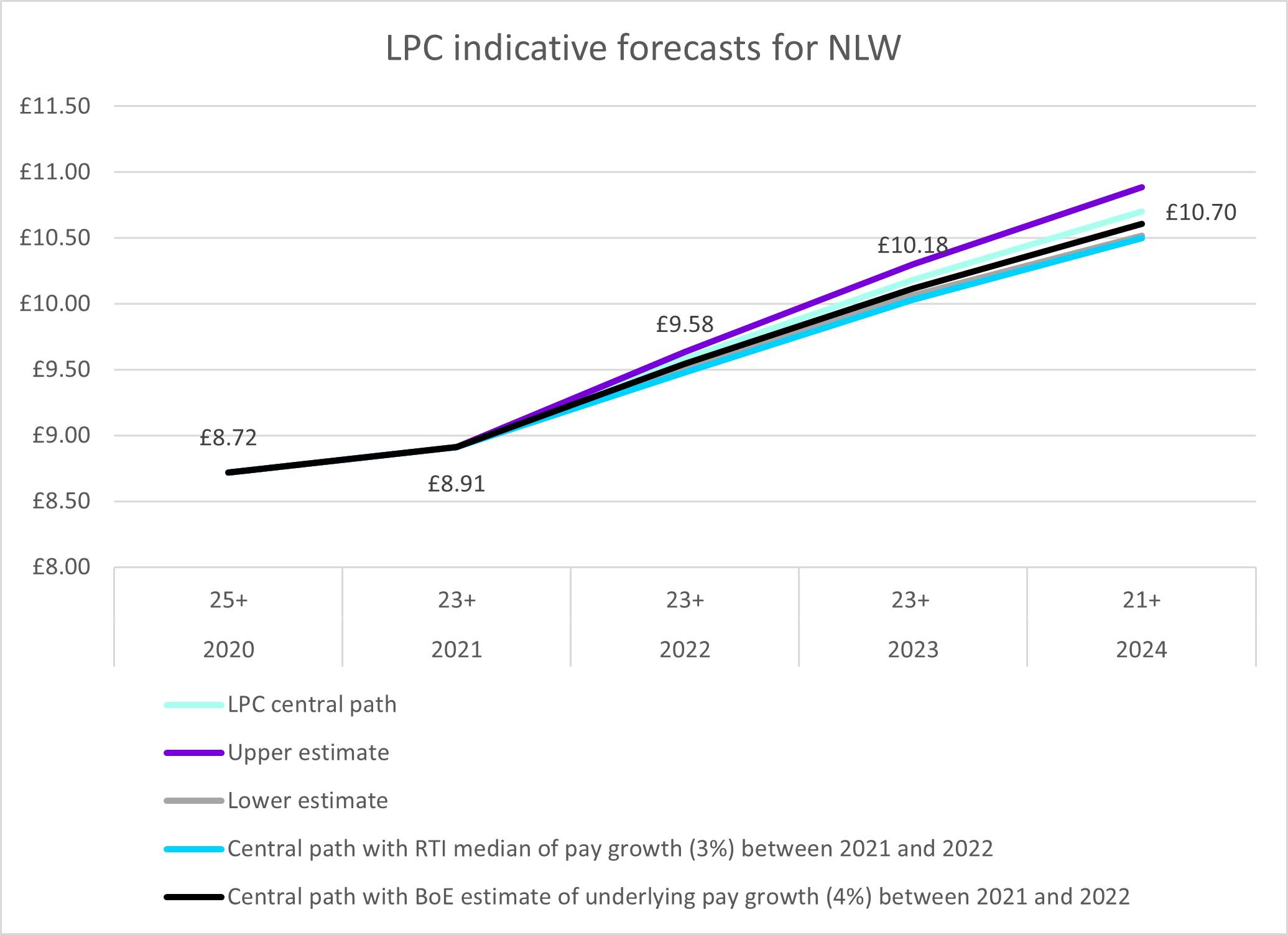Autumn spending review raises minimum wage and signals end of public sector pay freeze

The budget contained two main announcements of interest to pay specialists. One was that the highest band of the statutory minimum wage, termed the ‘National Living Wage’, is to rise by 6.6%, from £8.91 an hour to £9.50, from 1 April 2022. This was on foot of the latest set of recommendations from the Low Pay Commission (LPC), and means that the legal floor has broadly resumed its path towards its target of two-thirds of median earnings in 2024.
In its report, the LPC indicates that the NLW will need to be worth £10.70 in 2024 to reach this objective (see ‘LPC central path’ in the chart showing the LPC’s forecasts below). However, for April 2022 the body recommended a lower rate (£9.50) than this central path (£9.58 in chart below). This was for several reasons. Earnings growth measures may overstate underlying wage growth due to composition and base effects. Alternative estimates of earnings growth which account for these effects put the minimum wage on a lower path – see the ‘Real Time Information’ or RTI and Bank of England (BoE) estimates in the chart below. Also, the LPC’s central estimate creates a comparatively front-loaded path for the statutory floor, with a larger increase required in 2022 than in 2023 or 2024. The body said it did ‘not believe this is the right approach in the current economic circumstances’, with inter-related issues affecting global supply chains, rising input costs and staff availability all presenting risks to the economy.
Note: data labels in chart are for LPC central path only.
End of public sector freeze
The other main announcement was that public sector pay ‘will rise over the next three years as the recovery in the economy and labour market allows a return to a normal pay setting process.’ The Treasury has stipulated that any recommended pay rises ‘should retain broad parity with the private sector and continue to be affordable.’ This follows the findings of the Annual Survey of Hours and Earnings for 2021, released by the Office for National Statistics on 26 October, that while public sector earnings had risen by 2.5%, earnings growth in the private sector was higher at 3.6%. In addition, the regular Average Weekly Earnings series has estimated private sector earnings growth to be significantly ahead of that in the public sector for a number of months now. The announcement will be welcomed by public sector staff and managers, including in the civil service, where pay in many areas lags behind that for comparable roles in the private sector.
Other pay-related measures were trailed previously, such as the increase of 1.25% in National Insurance contributions (NICs). Since this applies to both employers and employees, its effect on pay pressures might be expected to be neutral, especially in those circumstances where pay uplifts are negotiated, but it nevertheless adds to the squeeze on employees’ living standards, as highlighted in this discussion of the budget by the Institute for Fiscal Studies.
Finally, we noticed a classic example of the Government’s continued predilection for ‘index shopping’ when it comes to its use of the different measures for inflation. The ‘Triple Lock’ for state pensions is to be suspended this year, mainly on account of significant fluctuations in one key element – the official measure of average earnings growth. Instead of pensions rising by the highest of earnings growth, inflation or 2.5%, they will rise by either inflation – as estimated by the CPI measure – or 2.5%. The CPI is regarded by statisticians as tending to underestimate inflation, and its use in this case is likely to be connected to the fact that pensions are an aspect of Government expenditure. On the other hand, when it comes to Vehicle Excise Duty – an instance of the Government levying a tax on citizens, next year’s rise will be based on the RPI, which generally estimates a higher rate of inflation than the CPI.